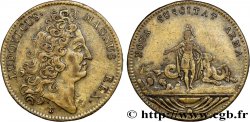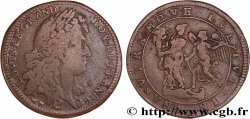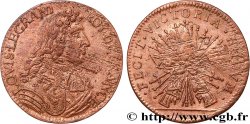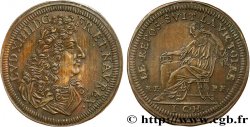E-auction 220-145296 - fjt_395046 - LOUIS XIV THE GREAT or THE SUN KING Revers de Charles de Laubespine n.d.
You must signin and be an approved bidder to bid, LOGIN TO BID. Accounts are subject to approval and the approval process takes place within 48 hours. Do not wait until the day a sale closes to register. Clicking on « bid » constitutes acceptance of the terms of use of cgb.fr private e-auctions.
Bids must be placed in whole Euro amounts only. The sale will start closing at the time stated on the item description; any bids received at the site after the closing time will not be executed. Transmission times may vary and bids could be rejected if you wait until the last second. For further information ckeck the E-auctions F.A.Q.
NO BUYER'S FEE.
NO BUYER'S FEE.
| Estimate : | 10 € |
| Price : | 3 € |
| Maximum bid : | 3 € |
| End of the sale : | 03 July 2017 18:23:00 |
| bidders : | 2 bidders |
Type : Revers de Charles de Laubespine
Date: n.d.
Mint name / Town : s.l.
Metal : brass
Diameter : 27 mm
Orientation dies : 6 h.
Weight : 6,28 g.
Edge : lisse
Rarity : R1
Catalogue references :
Obverse
Obverse description : Buste à droite de Louis XIV.
Reverse
Reverse legend : FLORET REDIVIVA VIGETQVE.
Reverse description : Aubépine remplissant le champ.
Reverse translation : Elle fleurit de nouveau et retrouve sa vigueur.
Commentary
Ce revers correspond au jeton de Charles de Laubespine, chancelier du roi, noble lyonnais.
mportant et intéressant article sur ce personnage dans wikipedia à http://fr.wikipedia.org/wiki/Charles_de_l%27Aubespine
Charles de L'Aubespine, marquis de Châteauneuf (1580-1653), est un homme politique français, connu par ses contemporains comme Châteauneuf ou le garde des sceaux de Châteauneuf[1].
Issu d'une vieille famille de conseillers et de secrétaires d'État, il est le petit fils de Claude de L'Aubespine, baron de Châteauneuf.
Il était abbé de Préaux.
Il avait été appelé en 1611 à la direction des finances avec Jeannin et de Thou. Il avait rempli diverses missions à l'étranger : il fut ambassadeur de France en Hollande (1609), à Valtellina (1626), et en Angleterre (1629).
Fait garde des sceaux par Richelieu en 1630 après la journée des Dupes, en remplacement de Michel de Marillac, il présida les commissions extraordinaires de justice qui condamnèrent à mort le maréchal Louis de Marillac et le duc Henri II de Montmorency.
Il était actif et travailleur, et semblait le docile instrument du cardinal. Néanmoins, il ne tarda pas à trahir Richelieu pour les beaux yeux de Mme de Chevreuse[2] : il lui révéla les projets de Louis XIII sur la forteresse lorraine de Moyenvic, et la duchesse en informa aussitôt Charles IV (1633). Le cardinal lui ôta alors les sceaux pour les donner à Séguier[3], et le fit jeter dans une prison du château d'Angoulême tandis que Mme de Chevreuse était exilée en Touraine.
Libéré à la mort de Louis XIII (1643), il participa à la cabale des Importants menée par la duchesse de Chevreuse contre Mazarin et fut de nouveau éloigné dès 1645.
Cependant, grâce au crédit de Mme de Chevreuse, Anne d'Autriche lui rendit les sceaux en mars 1650 mais les lui retira en avril 1651 et l'exila, à l'occasion du rapprochement provisoire entre Mazarin et de la Vieille Fronde[4]. Il réussit cependant à entrer au conseil après la majorité du jeune Louis XIV, mais il s'y trouva sans crédit à cause de ses intrigues passées et préféra se retirer au début de 1652, peu de temps avant de mourir à Leuville-sur-Orge (Essonne) (1653)..
mportant et intéressant article sur ce personnage dans wikipedia à http://fr.wikipedia.org/wiki/Charles_de_l%27Aubespine
Charles de L'Aubespine, marquis de Châteauneuf (1580-1653), est un homme politique français, connu par ses contemporains comme Châteauneuf ou le garde des sceaux de Châteauneuf[1].
Issu d'une vieille famille de conseillers et de secrétaires d'État, il est le petit fils de Claude de L'Aubespine, baron de Châteauneuf.
Il était abbé de Préaux.
Il avait été appelé en 1611 à la direction des finances avec Jeannin et de Thou. Il avait rempli diverses missions à l'étranger : il fut ambassadeur de France en Hollande (1609), à Valtellina (1626), et en Angleterre (1629).
Fait garde des sceaux par Richelieu en 1630 après la journée des Dupes, en remplacement de Michel de Marillac, il présida les commissions extraordinaires de justice qui condamnèrent à mort le maréchal Louis de Marillac et le duc Henri II de Montmorency.
Il était actif et travailleur, et semblait le docile instrument du cardinal. Néanmoins, il ne tarda pas à trahir Richelieu pour les beaux yeux de Mme de Chevreuse[2] : il lui révéla les projets de Louis XIII sur la forteresse lorraine de Moyenvic, et la duchesse en informa aussitôt Charles IV (1633). Le cardinal lui ôta alors les sceaux pour les donner à Séguier[3], et le fit jeter dans une prison du château d'Angoulême tandis que Mme de Chevreuse était exilée en Touraine.
Libéré à la mort de Louis XIII (1643), il participa à la cabale des Importants menée par la duchesse de Chevreuse contre Mazarin et fut de nouveau éloigné dès 1645.
Cependant, grâce au crédit de Mme de Chevreuse, Anne d'Autriche lui rendit les sceaux en mars 1650 mais les lui retira en avril 1651 et l'exila, à l'occasion du rapprochement provisoire entre Mazarin et de la Vieille Fronde[4]. Il réussit cependant à entrer au conseil après la majorité du jeune Louis XIV, mais il s'y trouva sans crédit à cause de ses intrigues passées et préféra se retirer au début de 1652, peu de temps avant de mourir à Leuville-sur-Orge (Essonne) (1653)..







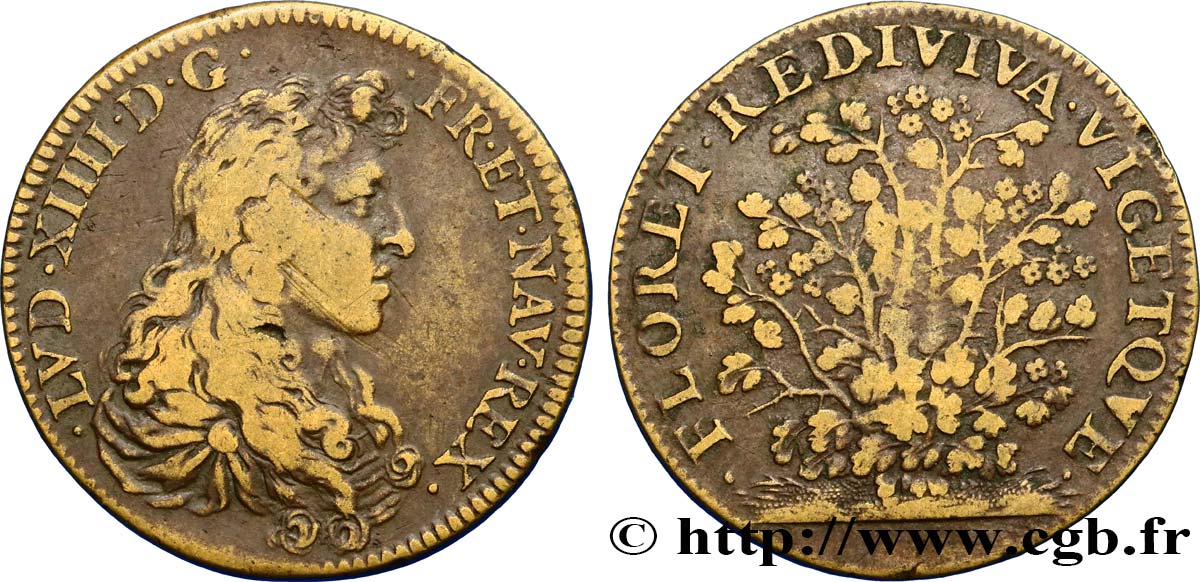
 Report a mistake
Report a mistake Print the page
Print the page Share my selection
Share my selection Ask a question
Ask a question Consign / sell
Consign / sell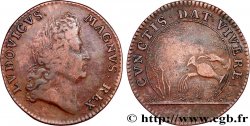
 Full data
Full data